Enhancing the Properties of Cement Composites Using Granulated Hemp Shive Aggregates
Abstract
:1. Introduction
2. Materials and Methods
2.1. Materials
2.1.1. Organic Filler
2.1.2. Cement
2.1.3. Bituminous Emulsion
2.1.4. Plasticizers and Mineralizers
2.1.5. Water
2.2. Methods
2.2.1. Properties of Organic Fillers
Water Adsorption
Bulk Density in the Loose and Compacted State
2.2.2. Composite Mixture Testing
Composite Mixture Consistency
Density of the Composite Mixture
2.2.3. Cement-Composite Testing
Compressive Strength of Cement Composite
Apparent Density of Cement Composite
Water Absorption of Cement Composite
Capillary Water Absorption
Scanning Electron Microscopy
2.3. Preparation of Samples
2.3.1. Pelletization
2.3.2. Mineralization of Granules and Hemp Shives
2.3.3. Shaping and Care of Samples
2.3.4. Development of the Experiment Plan
3. Results
3.1. Properties of Organic Fillers
3.2. Consistency of the Composite Mixture
3.3. Bulk Density of the Composite Mixture
3.4. Compressive Strength of the Cement Composite
3.5. Water Absorption of the Cement Composite
3.6. Apparent Density of the Cement Composite
3.7. Capillary Rise
3.8. Structure Imagining
4. Summary
- -
- The use of potato starch in the production of granules did not significantly affect their properties. The anticipated reduction in water absorption could potentially be achieved by altering the binding substance used in granule production. The bulk density of granules with starch is very similar to that of granules without starch.
- -
- In the compressive strength test, composites with granules exhibited a low compressive strength of 0.3 MPa. Samples with granules were completely destroyed, unlike those with only shives, which were crushed and delaminated.
- -
- The hemp granulation process positively impacted the consistency and density of the mixture and reduced the absorbability of cement composites by approximately 10–20%. However, there was a marked decrease in the compressive strength of composites with granules compared to those made with shives.
- -
- Capillary action tests indicated that composites with granules had a lower weight gain of 10–20% compared to composites with shives. However, after a few days, cracks appeared on the walls of the granule samples, indicating that prolonged contact with water causes irreversible structural changes in the composite.
- -
- A viable solution could be to use a different type of binder in granule production.
Author Contributions
Funding
Institutional Review Board Statement
Informed Consent Statement
Data Availability Statement
Conflicts of Interest
References
- Barbhuiya, S.; Das, B.B. A comprehensive review on the use of hemp in concrete. Constr. Build. Mater. 2022, 341, 127857. [Google Scholar] [CrossRef]
- Meyer, C. The greening of the concrete industry. Cem. Concr. Compos. 2009, 31, 601–605. [Google Scholar] [CrossRef]
- Malhotra, V.M. Role of supplementary cementing materials in reducing greenhouse gas emissions. In Concrete Technology for a Sustainable Development in the 21st Century, 1st ed.; Gjorv, E.O., Sakai, K., Eds.; CRC Press: London, UK, 2000. [Google Scholar]
- Bevan, R.; Woolley, T. Hemp Lime Construction: A Guide to Building with Hemp Lime Composites, Bracknell; IHS BRE Press: Garston/Watford, UK, 2008. [Google Scholar]
- Jamroży, Z. Beton i Jego Technologie (Eng: Concrete and Its Technologies); PWN: Warsaw, Poland, 2005. [Google Scholar]
- Brzyski, P.; Filc, S. Charakterystyka Kompozytu Wapienno-Konopnego i Jego Zastosowanie w Budownictwie (Eng: Characteristics of Lime-Hemp Composite and Its Use in Construction Industry). Bud. I Archit. 2015, 14, 11–19. [Google Scholar] [CrossRef]
- Stanwix, W.; Sparrow, A. The Hempcrete Book Designing and Building with Hemp-Lime; Green Books: London, UK, 2014. [Google Scholar]
- Brzyski, P. Kompozyt Wapienno-Konopny, CZĘŚĆ 1: Charakterystyka i Technologia Wykonania (Eng: Lime-Hemp Composite, Part 1: Characteristics and Manufacturing Technology). Builder 2016, 224, 70–72. [Google Scholar]
- Dawdo, C. Wiórobeton w Budownictwie: Właściwości, Projektowanie, Produkcja, Zastosowanie (Eng: Chip Concrete in Construction: Properties, Design, Production, Application); Bialystok University of Technology Publishing House: Bialystok, Poland, 1994. [Google Scholar]
- Hemp Buildings. Available online: http://budynkizkonopi.pl/ (accessed on 30 March 2024).
- Farmer. Available online: https://www.farmer.pl/ (accessed on 30 March 2024).
- Yadav, M.; Saini, A. Opportunities & challenges of hempcrete as a building material for construction: An overview. Mater. Today Proc. 2022, 65, 2021–2028. [Google Scholar] [CrossRef]
- Malabadi, R.B.; Kolkar, K.P.; Chalannavar, R.K. Industrial Cannabis sativa (Hemp fiber): Hempcrete-A Plant Based and Eco-friendly Building Construction Material. IJIAR 2023, 8, 67–78. [Google Scholar] [CrossRef]
- Hemp. Available online: https://www.konopie.info.pl/ (accessed on 30 March 2024).
- Bołtryk, M.; Krupa, A.; Pawluczuk, E. Modification of the properties of the cement composites with the organic filler. Constr. Build. Mater. 2018, 167, 143–153. [Google Scholar] [CrossRef]
- Ip, K.; Miller, A. Life cycle greenhouse gas emissions of hemp-lime wall constructions in the UK. RCR Adv. 2012, 69, 1–9. [Google Scholar] [CrossRef]
- Walker, R.; Pavía, S.; Mitchell, R. Mechanical properties and durability of hemp-lime concretes. Constr. Build. Mater. 2014, 61, 340–348. [Google Scholar] [CrossRef]
- Elfordy, S.; Lucas, F.; Tancret, F.; Scudeller, Y.; Goudet, L. Mechanical and thermal properties of lime and hemp concrete (“hempcrete”) manufactured by a projection process. Constr. Build. Mater. 2008, 22, 2116–2123. [Google Scholar] [CrossRef]
- CEMEX. Available online: https://www.cemex.pl/ (accessed on 30 March 2024).
- EN 196-3; Methods of Testing Cement—Part 3: Determination of Setting Times and Soundness. European Committee for Standardization: Brussels, Belgium, 2005.
- EN 196-4; Methods of Testing Cement—Part 4: Quantitative Determination of Constituents. European Committee for Standardization: Brussels, Belgium, 2005.
- EN 196-6; Methods of Testing Cement—Part 6: Determination of Fineness. European Committee for Standardization: Brussels, Belgium, 2005.
- EN 196-1; Methods of Testing Cement—Part 1: Determination of Strength. European Committee for Standardization: Brussels, Belgium, 2005.
- EN 196-2; Methods of Testing Cement—Part 2: Chemical Analysis of Cement. European Committee for Standardization: Brussels, Belgium, 2005.
- EN 196-21; Methods of Testing Cement—Part 21: Determination of the Chloride, Carbon Dioxide and Alkali Content of Cement. European Committee for Standardization: Brussels, Belgium, 2005.
- ARTBUD. Available online: https://www.artbud.pl/ (accessed on 30 March 2024).
- CHRYSO. Available online: https://www.chryso.pl/p/9495/chryso-alpha-304 (accessed on 27 June 2024).
- EN 1097-6:2013; Tests for Mechanical and Physical Properties of Aggregates—Part 6: Determination of Particle Density and Water Absorption. European Committee For Standardization: Brussels, Belgium, 2013.
- EN 1097-3:1998; Tests for Mechanical and Physical Properties of Aggregates—Part 3: Determination of Loose Bulk Density and Voids. European Committee For Standardization: Brussels, Belgium, 1998.
- EN 12350-2:2019; Testing Fresh Concrete—Part 2: Slump Test. European Committee For Standardization: Brussels, Belgium, 2019.
- EN 12350-6:2019; Testing Fresh Concrete—Part 6: Density. European Committee For Standardization: Brussels, Belgium, 2019.
- EN 12390-3:2019; Testing Hardened Concrete—Part 3: Compressive Strength of Test Specimens. European Committee For Standardization: Brussels, Belgium, 2019.
- EN 12390-7:2019; Testing Hardened Concrete—Part 7: Density of Hardened Concrete. European Committee For Standardization: Brussels, Belgium, 2019.
- EN 206:2013+A2:2021; Concrete—Specification, Performance, Production and Conformity. European Committee For Standardization: Brussels, Belgium, 2021.
- PN-B-04500:1985; Building Mortars—Testing of Physical and Strength Properties. Polish Committee for Standardization: Warsaw, Poland, 1985.
- Joka Yildiz, M.; Cwalina, P.; Obidziński, S. A comprehensive study of buckwheat husk co-pelletization for utilization via combustion. Biomass Conv. Biorefinery 2022. [Google Scholar] [CrossRef]
- Bołtryk, M.; Pawluczuk, E. Properties of a lightweight cement composite with an ecological organic filler. Constr. Build. Mater. 2014, 51, 97–105. [Google Scholar] [CrossRef]
- Pantawee, S.; Sinsiri, T.; Jaturapitakkul, C.; Chindaprasirt, P. Utilization of hemp concrete using hemp shiv as coarse aggregate with aluminium sulfate [Al2(SO4)3] and hydrated lime [Ca(OH)2] treatment. Constr. Build. Mater. 2017, 156, 435–442. [Google Scholar] [CrossRef]
- Khedari, J.; Suttisonk, B.; Pratinthong, N.; Hirunlabh, J. New lightweight composite construction materials with low thermal conductivity. Cem. Concr. Compos. 2001, 23, 65–70. [Google Scholar] [CrossRef]
- Brooks, A.L.; Zhou, H.; Hanna, D. Comparative study of the mechanical and thermal properties of lightweight cementitious composites. Constr. Build. Mater. 2008, 159, 316–328. [Google Scholar] [CrossRef]


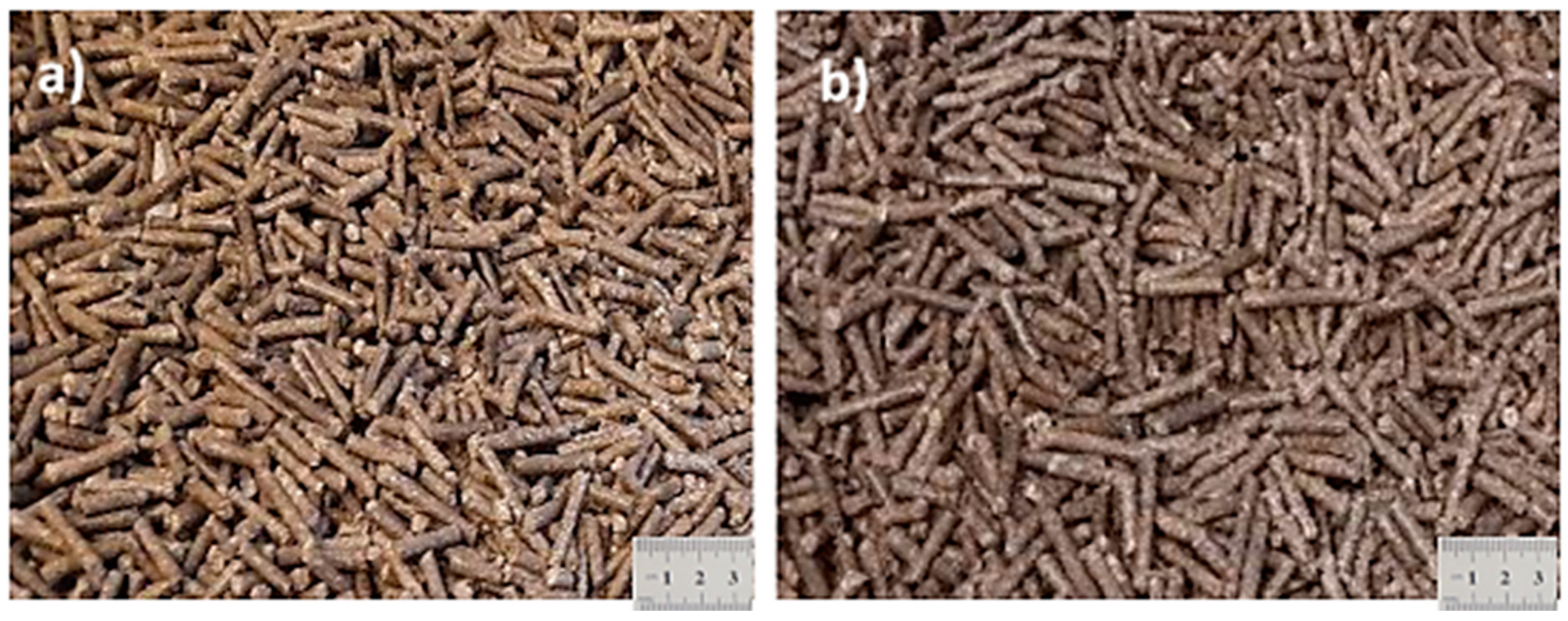
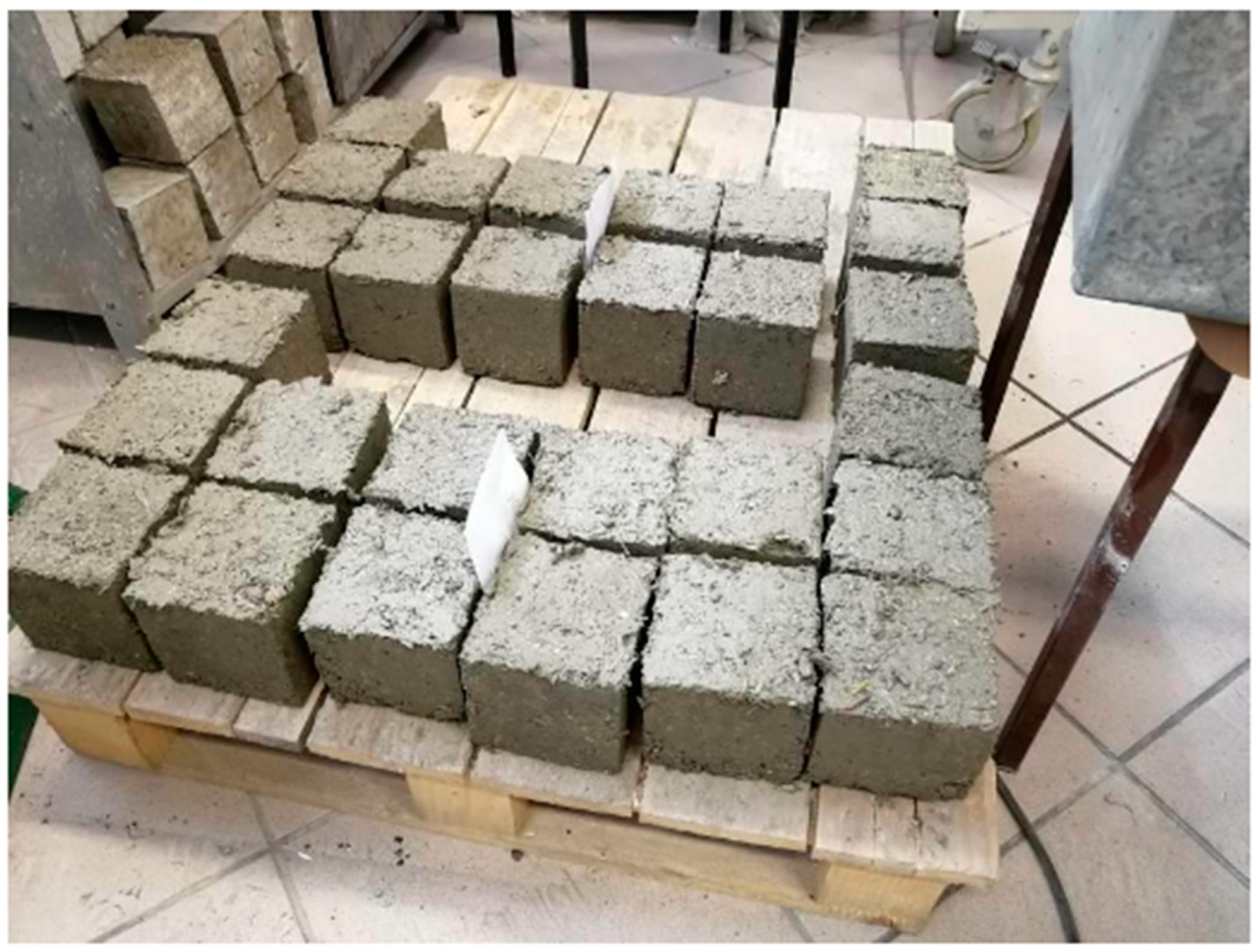


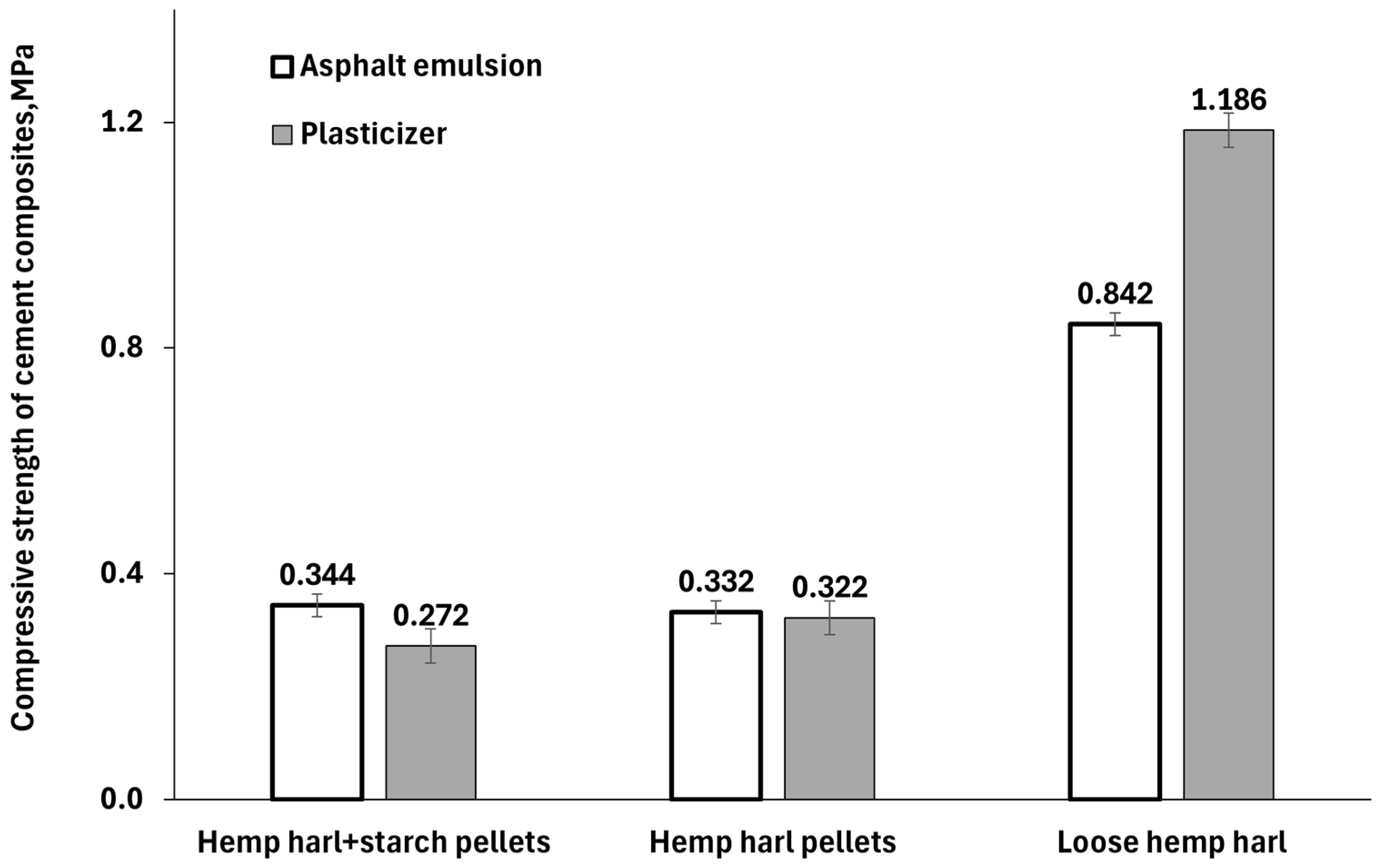
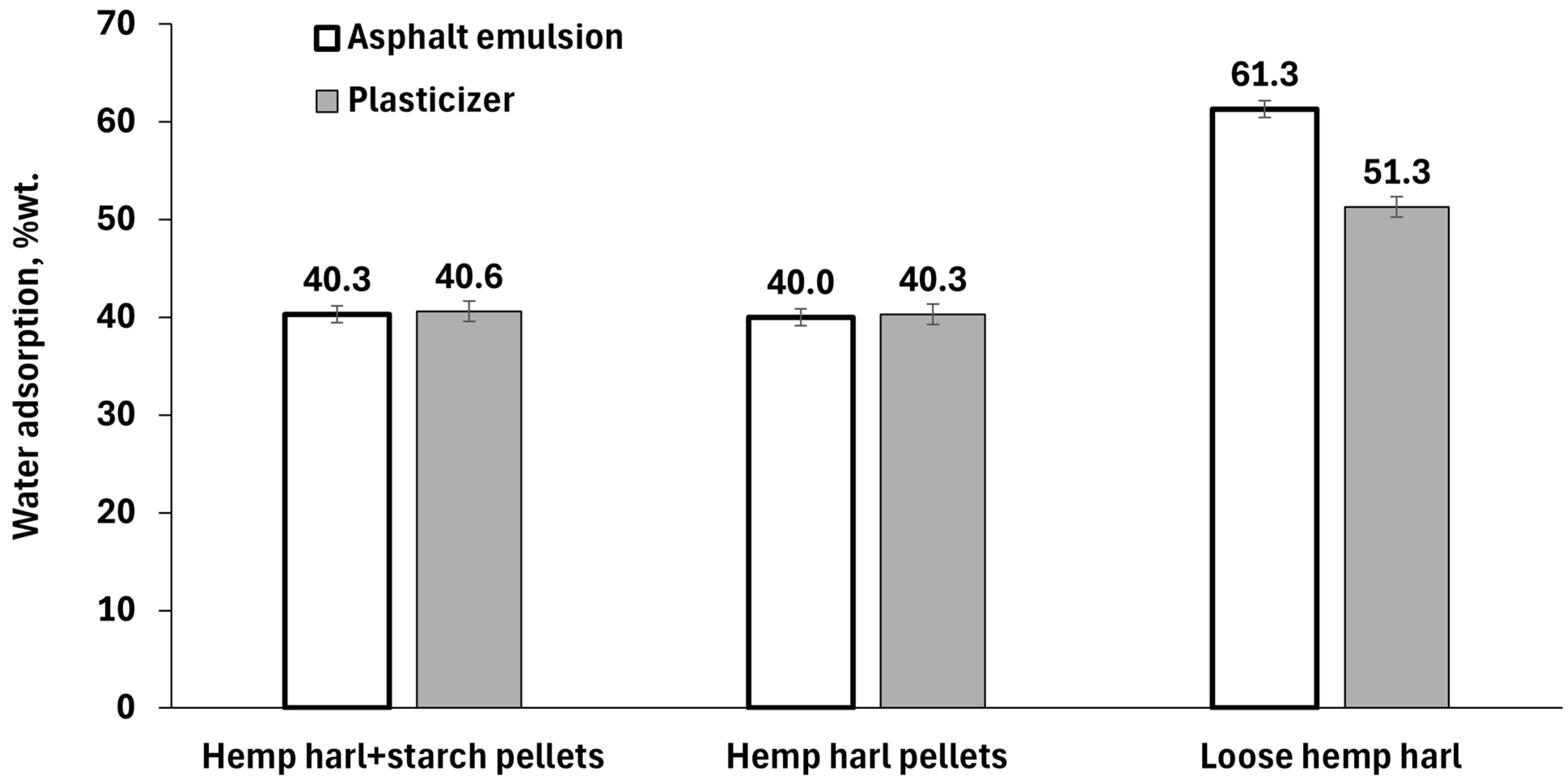


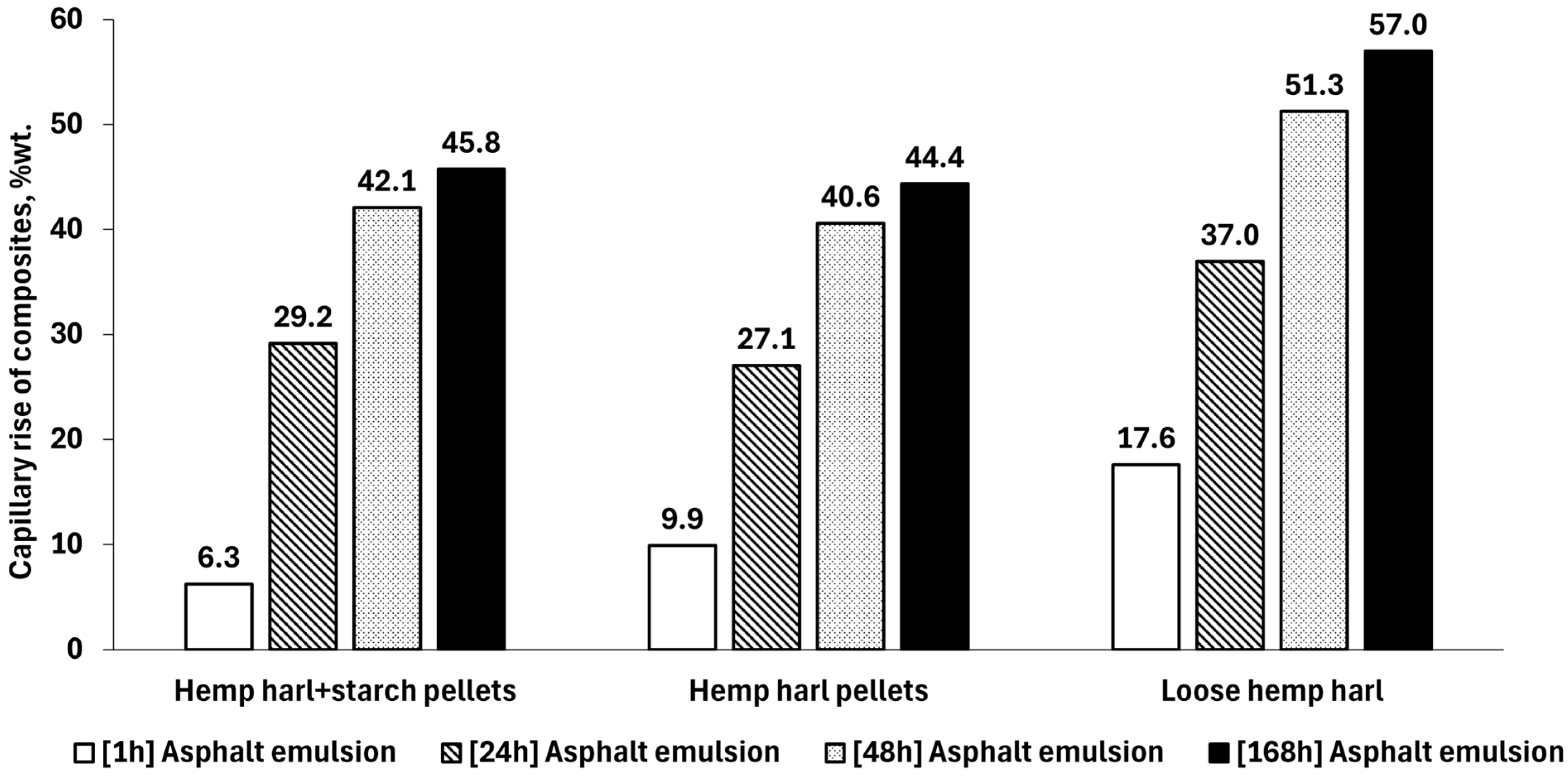
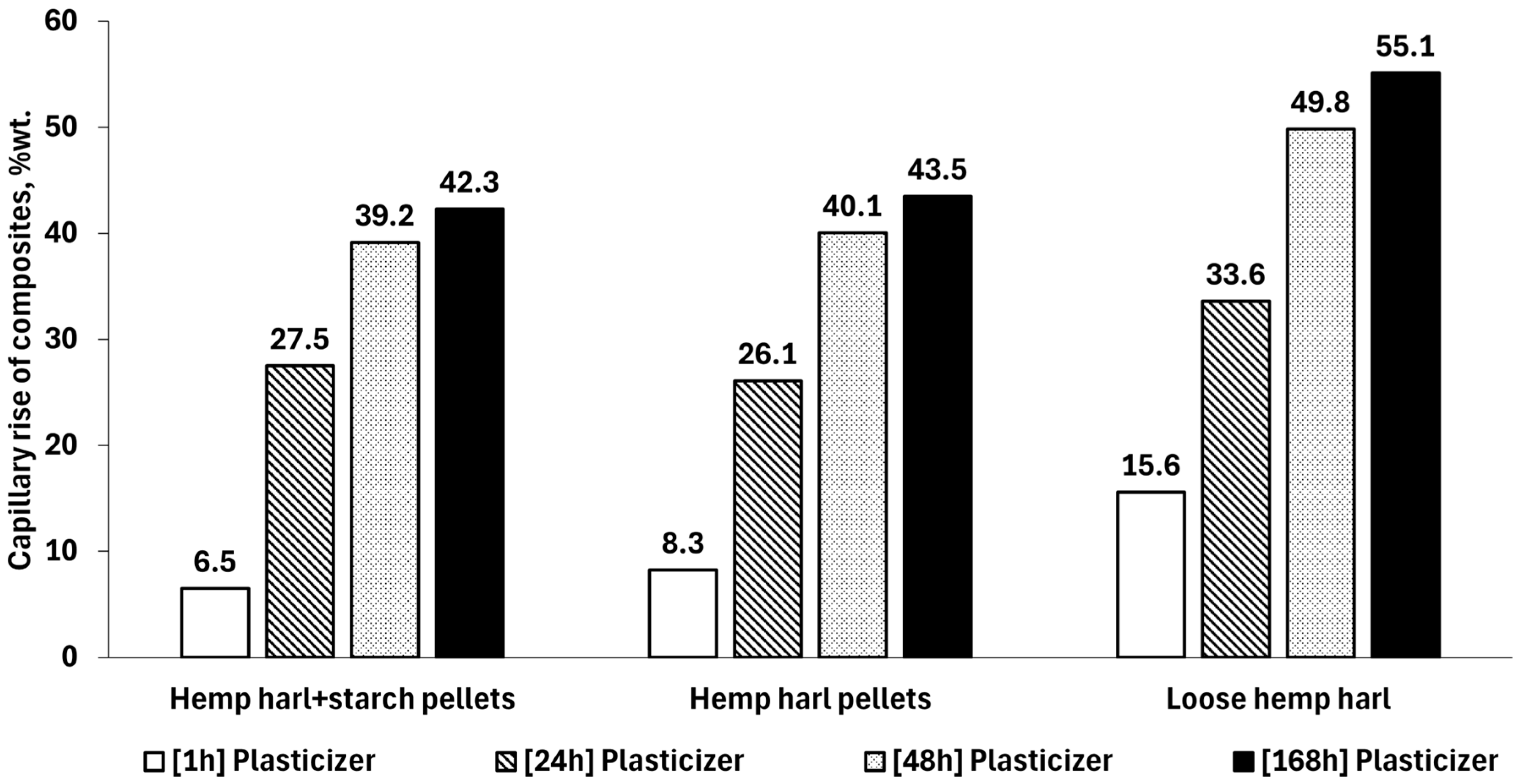



| Property | Test Standard | Standard Requirements | Test Results |
|---|---|---|---|
| Initial setting time, min | EN 196-3 [20] | ≥60.0 | 187 |
| Final setting time, min | EN 196-4 [21] | - | 248 |
| Specific surface area, cm2/g | EN 196-6 [22] | - | 3746 |
| Soundness of cement, mm | EN 196-3 [20] | ≤10.0 | 1.6 |
| Compressive strength, MPa | EN 196-1 [23] | ||
| -after 2 days | ≥20.0 | 25.6 | |
| -after 28 days | ≥42.5 ≤ 62.5 | 54.3 | |
| SO3 content, % | EN 196-2 [24] | ≤4.0 | 2.98 |
| Cl content, % | EN 196-21 [25] | ≤0.1 | 0.079 |
| Insoluble residue, % | EN 196-2 [24] | ≤5.0 | 0.79 |
| Loss on ignition, % | EN 196-2 [24] | ≤5.0 | 3.24 |
| Alkali content as Na2O eq, % | EN 196-21 [25] | - | 0.60 |
| Specific density (g/cm3) | EN 196-6 [22] | - | 3.10 |
| Property | Value |
|---|---|
| Solvent | lack |
| Consistency | liquid |
| Color | black |
| Density | ca. 1000 kg/m3 |
| Dry residue | 60%wt. |
| Property | Value |
|---|---|
| Consistency | Liquid |
| Color | Colorless |
| Density | 1020 ± 2 kg/m3 |
| pH | 4 ± 1 |
| Cl− content | ≤0.1% |
| Alkali content as Na2O eq. | ≤1.0% |
| No. | Cement CEM I 42.5R | Water | Plasticizer | Asphalt Emulsion | Sand | Fillers | Mineralizers | |||
|---|---|---|---|---|---|---|---|---|---|---|
| Hemp Harl Pellets | Loose Hemp Harl | Aluminum Sulfate Al2(SO4)3 | Hydrated Lime Ca(OH)2 | |||||||
| Starch | - | |||||||||
| kg | dm3 | kg | Kg | kg | kg | kg | kg | kg | kg | |
| 1 | 360 | 519 | - | 3.6 | 182 | 337 | - | - | 30 | 60 |
| 2 | 360 | 519 | 3.6 | - | 182 | 337 | - | - | 30 | 60 |
| 3 | 360 | 519 | - | 3.6 | 182 | - | 337 | - | 30 | 60 |
| 4 | 360 | 519 | 3.6 | - | 182 | - | 337 | - | 30 | 60 |
| 5 | 360 | 519 | - | 3.6 | 187 | - | - | 224 | 20 | 40 |
| 6 | 360 | 519 | 3.6 | - | 187 | - | - | 224 | 20 | 40 |
| Property | Hemp Harl Pellets | Hemp Harl + Starch Pellets | Loose Hemp Harl |
|---|---|---|---|
| Density in loose state, kg/m3 | 725 ± 2 | 726 ± 2 | 409 ± 1 |
| Density in a compacted state, kg/m3 | 745 ± 1 | 746 ± 1 | 495 ± 1 |
| Water absorption, %wt | 287 ± 1.5 | 285 ± 0.6 | 343 ± 1 |
| No. | Mixture Composition | Slump, cm | Consistency Class |
|---|---|---|---|
| 1 | Hemp harl–starch pellets + asphalt emulsion | 5.8 | S2 |
| 2 | Hemp harl–starch pellets + plasticizer | 8.0 | S2 |
| 3 | Hemp harl pellets + asphalt emulsion | 8.7 | S2 |
| 4 | Hemp harl pellets + plasticizer | 13.1 | S3 |
| 5 | Loose hemp harl + asphalt emulsion | 0.4 | S1 |
| 6 | Loose hemp harl + plasticizer | 3.9 | S1 |
Disclaimer/Publisher’s Note: The statements, opinions and data contained in all publications are solely those of the individual author(s) and contributor(s) and not of MDPI and/or the editor(s). MDPI and/or the editor(s) disclaim responsibility for any injury to people or property resulting from any ideas, methods, instructions or products referred to in the content. |
© 2024 by the authors. Licensee MDPI, Basel, Switzerland. This article is an open access article distributed under the terms and conditions of the Creative Commons Attribution (CC BY) license (https://creativecommons.org/licenses/by/4.0/).
Share and Cite
Kalinowska-Wichrowska, K.; Joka Yildiz, M.; Pawluczuk, E.; Zgłobicka, I.; Franus, M.; Nietupski, W.; Pantoł, M. Enhancing the Properties of Cement Composites Using Granulated Hemp Shive Aggregates. Sustainability 2024, 16, 6142. https://doi.org/10.3390/su16146142
Kalinowska-Wichrowska K, Joka Yildiz M, Pawluczuk E, Zgłobicka I, Franus M, Nietupski W, Pantoł M. Enhancing the Properties of Cement Composites Using Granulated Hemp Shive Aggregates. Sustainability. 2024; 16(14):6142. https://doi.org/10.3390/su16146142
Chicago/Turabian StyleKalinowska-Wichrowska, Katarzyna, Magdalena Joka Yildiz, Edyta Pawluczuk, Izabela Zgłobicka, Małgorzata Franus, Wojciech Nietupski, and Magdalena Pantoł. 2024. "Enhancing the Properties of Cement Composites Using Granulated Hemp Shive Aggregates" Sustainability 16, no. 14: 6142. https://doi.org/10.3390/su16146142








